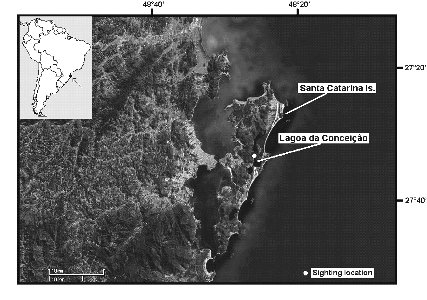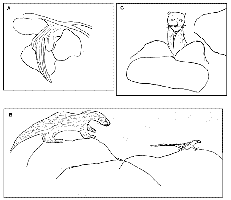 |
Last Update:
Thursday November 22, 2018
|
| [Home] |
The neotropical otter, Lontra longicaudis,(Olfers, 1818) has a large distribution in Latin America, occurring in Central and South America, and has its austral limit in northern Argentina (Chehebar, 1990). In Brazil, although there are records of the species' occurrence in coastal marine areas (Blacher, 1987; Alarcon and Simões-Lopes, 2003, 2004), it is a general belief that the sea is a transit area for the neotropical otter, which concentrates its feeding habits mostly in fresh water environments. Otters are opportunistic feeders in that they feed upon whatever available prey, mostly reported on slower moving fish (Mason and Macdonald 1987; Taastrøm and Jacobsen, 1999) because of their vulnerability to predation. Sightings of live otters in their natural environment are uncommon mainly because otters are known to have shy habits, avoiding human presence, hence the majority of ecological studies relying on indirect observation methods (Blacher, 1987; Passamani and Camargo, 1995, Quadros and Monteiro-Filho, 2001, Kasper et al., 2004), mainly by documenting their typical behavior of defecating at prominent places within their home ranges (eg. Beja 1991, Passamani and Camargo, 1995; Quadros and Monteiro-Filho, 2001). This paper aims to report an unusual sighting of interaction between a neotropical otter and a teju lizard in a lagoon environment of southern Brazil. The Hydrographic Basin of Lagoa da Conceição is located on the east coast of Santa Catarina Island (27º27S, 48º22’W), covering an area of 116.78 Km² (IPUF, 1998) (Figure 1). It extends in a north-south orientation, ranging 13.5km in length, varying in width from 200m to 2.5km. The lagoon is linked to the sea by a shallow 2.5km long channel, which reduces the tide effects inside the lagoon (Odebrech and Caruso Junior, 1987). The freshwater contribution to the Lagoa da Conceição comes from regular rain precipitation, from small watercourses on the western border and from Capivaras River, which reaches the northern point of the lagoon (Dutra, 1990). The study area has a subtropical climate, characterized by a yearly average temperature of 20.4°C and a relative air humidity of 80%.
The once abundant Atlantic Rain Forest is limited to the Protected Areas, such as the granite hills surrounding the lagoon (CECCA, 1997). During the last 15 years the human population in Lagoa da Conceição has increased three-fold and the local development for tourism and national migration is bringing serious environmental concerns, such as lagoon pollution and occupation of protected areas (Hauff, 1996; CECCA, 1997, 2001). During a trekking in Costa da Lagoa (27°S, 48°W), on October 22nd, 2005, I opportunistically sighted a neotropical otter, which I have estimated to be no more than one meter long, at a site approximately 40m away from the lagoon. That location was a typical otter habitat, covered by rocks and vegetation, and near water with good shelter opportunities (Chehebar, 1990; Waldemarin et al., 1998). The animal crossed about 15m from me, at an elevated position in relation to my eyes, because it was on the rocks. The sighting comprised of two quick observations. First, the otter was identified from behind, by its characteristic conic bulky tail and brown pelage, moving fast and going northwards along the trail (Figure 2A). I heard what sounded like steps (breaking branches), and when looking in the direction of the sound, I saw a teju lizard (Tupinambis merianae) (Linnaeus, 1758) of about 40 centimeters running away from another larger animal among the vegetation and rocks (Figure 2B). Less than one minute later, I could identify the animal as being the otter, which remained pointed toward me and looking in my direction, clearly showing its face. At this time I could see that the otter had a piece of a reptile tail coming out of its mouth (Figure 2C), linking this event to the previously observed teju lizard. The literature contains innumerable items of information regarding the otter’s diet and while reptiles are listed as potential prey, few works report on this (see also Beja, 1991; Helder and Andrade, 1997; Alarcon and Simões-Lopes, 2004). Clavero et al. (2005) are one of the few who report more detailed information about amphibian and reptile consumption by otters (Lutra lutra) in the Iberian Peninsula, describing prey species and seasonality of predation by the otters. Despite the feeding habits of the otters being well documented, they fail to report on any other report sighting of predation on land. In fact, even if otters are known to feed on reptiles, these are usually aquatic species (Clavero et al., 2005). Some studies in Brazil have shown that the feeding habits of L. longicaudis in coastal marine environments presented similar patterns compared with the species' diet in freshwater ecosystems. In the Environmental Protected Area (EPA) of Anhatomirim, Alarcon and Simões-Lopes (2004) identified that fish constitute the dominant prey group, as similarly reported in other studies carried out on the same species in rivers and lagoons of South America (Carvalho, 1990; Blacher and Soldatelli, 1996; Helder and Andrade, 1997; Pardini, 1998; Quadros and Monteiro-Filho, 2001; Gori et al., 2003). Crustaceans are commonly cited as the second main prey group for L. longicaudis (Helder and Andrade, 1997; Pardini, 1998; Quadros and Monteiro-Filho, 2001), with some exceptions, where it can appear as the dominant group (Spinola and Vaughan, 1998) or be absent (Kasper et al., 2004). Other prey groups such as amphibians, clams, mammals, and insects appeared in low frequency in southern Brazil, whether in coastal marine environments (Alarcon and Simões-Lopes, 2003) or in freshwater environments (Helder and Andrade, 1997; Pardini, 1998; Quadros and Monteiro-Filho, 2001). A richness of species in L. longicaudis diets going up to 7 suggests that escaping ability is the main factor influencing the selection of the otters’ preys (Pardini, 1998; Gori et al., 2003; Kasper et al., 2004). In another area of Southern Brazil, Vale do Taquari, six prey groups, fish (89%), mammals (8,8%), insects (5,6%), birds (1,6%), amphibians (0,8%) and mollusks (0,8%) were found in 263 samples (Kasper et al., 2004). No evidences of feeding on reptiles were found. The described observation brings important new information about the opportunistic otter foraging behavior, of predation on a teju lizard in a coastal lagoon of Southern Brazil, mainly to the fact that the lizard was not captured in the water but on land. The patterns of coastal habitat use by L. longicaudis are still not well understood. For a better understanding of the diverse potential preys taken by foraging otters, we need more information about prey availability and anthropogenic impacts such as over-fishing and intensive exploration of the coastal zones for tourism activities. Such information should also be useful to implement local conservation strategies for neotropical otters and their environment. ACKNOWLEDGMENTS - I deeply thank Gisele Alarcon for encouraging me to write this note. José Prenda, Carlos Benhur Kasper and Lene Jacobsen provided crucial literature material. Moara Rossi-Santos co-observed the interaction in the field. I also thank two anonymous referees who kindly reviewed this manuscript. REFERENCES Alarcon, G.G. and Simões-Lopes, P.C. ( 2003). Preserved versus degraded coastal environments: a case study of the Neotropical otter in the Environmental Protection Area of Anhatomirim, Southern Brazil. IUCN Otter Spec. Group Bull. 20: 6-18. Résumé : Regard sur l'Interaction Entre une Loutre Néotropicale (Lontra longicaudis) et un Lézard Téju (Tupinambis merinae) dans un Écosystème Lagunaire du Sud du Brésil Resumen:Avistaje de una Interacción entre una Nutria de Río Neotropical, Lontra longicaudis, y un Lagarto Blanco, Tupinambis merianae, en un Ambiente Lacustre del Sur de Brasil |
| [Copyright © 2006 - 2050 IUCN/SSC OSG] | [Home] | [Contact Us] |


